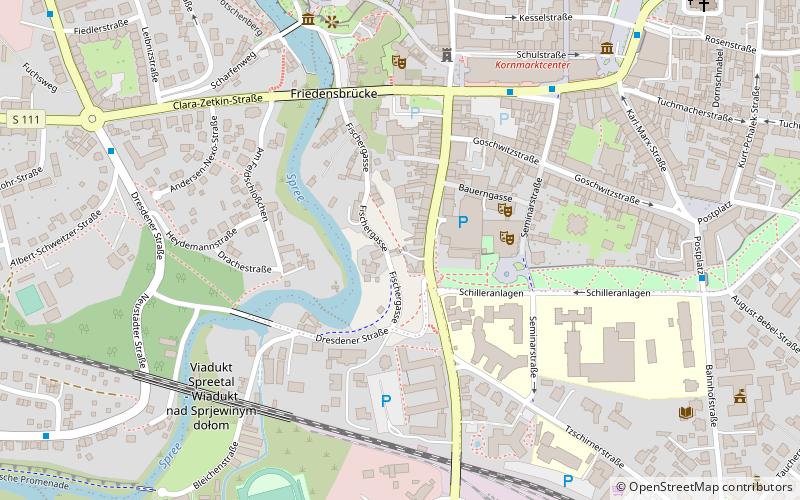Neue Wasserkunst, Bautzen


Facts and practical information
The Neue Wasserkunst, Sorbian Nowa wodarnja, in Bautzen is, like the Alte Wasserkunst, a former facility for the city's water supply, located on a rock plateau above the valley of the Spree River. The structure, which is still preserved today and was newly built in 1721, is located in the south of the old town at the entrance from the Spree valley to the Neutor on Lauenstraße.
The old waterworks, which had already been built in the 15th century, could no longer meet the increasing demand for water by the beginning of the 17th century at the latest. Therefore, the city council planned the construction of a second pumping station, also in order to be able to provide more fire-fighting water in the future in case of fire. A site was chosen for the construction near the Outer Lauentor, where the Spree comes particularly close to the steep slope of the valley. On July 24, 1606, the mayor of Bautzen, Schönborn, and the master builder Wenzel Röhrscheidt the Younger laid the foundation stone. A bottle of Rhenish wine as well as a document and a picture of the former mayor Melchior Piccius were placed in it.
The extraction structure, located on the Spree River, was completed as late as 1606. In 1607, work began on the covered tube walkway leading up the slope, as well as the tower. One evening in July 1608, master builder Röhrscheidt suffered a serious setback when the tower of the waterworks collapsed at around 9 pm. This destroyed two houses in the Fischergasse below, killing a 15-year-old boy. The disaster was caused by an unsuitable binding agent. By the onset of winter, the tower had been rebuilt under the special supervision of the city council and the hood had been put on.
Although water pipes had already been laid from the Neue Wasserkunst to the Fleischmarkt in the old town, the structure could not be inaugurated until July 2, 1610. But the further history of the building is also marked by catastrophes. In the winter of 1618, the tower burned out after an attempt to thaw frozen water pipes. In 1620, the upper part of the tower was destroyed during the siege by Swedish troops. In the following 100 years the waterworks deteriorated more and more, several times it burned there.
In 1721, the waterworks were completely rebuilt, this time in stone and with a domed roof to make it more resistant. In the following decades, constant repair work was necessary on the lift and the pumps, and in 1874 a steam engine was installed at the extraction station to meet the increased demand for water due to industrialization. However, the development of industry on the upper reaches of the Spree also meant that the river water became increasingly undrinkable and the city looked for other ways of supplying water. As a result, several deep wells were constructed, from which the pipelines were now fed. In 1893, the New Waterworks was shut down. In 1937, the tower was extensively renovated. In 1999, another comprehensive renovation began, which was completed in 2000.
In the substructure of the New Waterworks is the Neutor, which was formerly part of the Outer Lauentor. With its location at the southern end of the city, the Wasserkunst, in addition to its actual function, was also part of the city's defense system at the passage of Frankenstrasse through the city gate.
Aeussere Lauenstr. 62Bautzen 02625
Neue Wasserkunst – popular in the area (distance from the attraction)
Nearby attractions include: Cathedral of St Peter, Protschenberg, Sorbisches Museum, Gedenkstätte Bautzen.
Frequently Asked Questions (FAQ)
Which popular attractions are close to Neue Wasserkunst?
How to get to Neue Wasserkunst by public transport?
Bus
- Bautzen Lauengraben • Lines: 103, 115, 122, 180, 190, 198, 2, 3, 5, 530, 6, 7 (5 min walk)
- Bautzen Packhofstraße • Lines: +510, +511, +514, 115, 3, 4 (7 min walk)
Train
- Bautzen / Budyšin (11 min walk)











